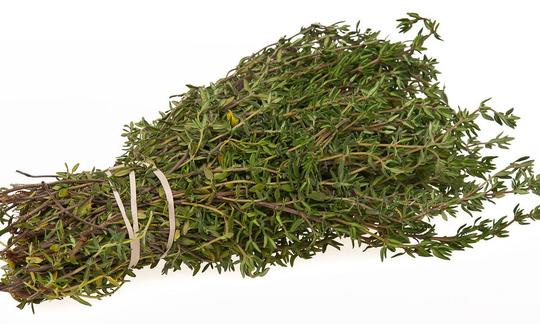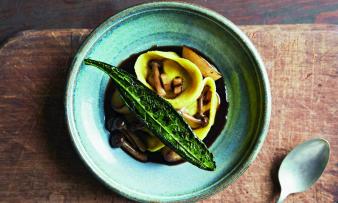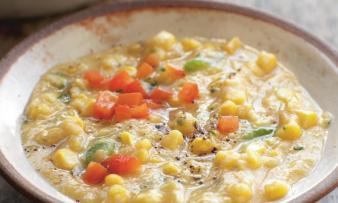Table of contents
Fresh thyme ( Thymus vulgaris ) is mainly used raw as a conventional or organic spice in the kitchen.
Use in the kitchen
Thyme is an important herb. It is best to buy it fresh in a herb pot from a garden center or organic store. It tastes slightly sweet and at the same time a little tart and bitter.
How can you use fresh thyme? You harvest the entire shoots of the plant, but only the leaves are suitable for seasoning. The stem of the thyme branch contains a lot of bitter substances and can therefore give off an undesirable bitter taste. You therefore have to carefully pluck the leaves from the branch. Stripping and then chopping the herb leaves is called "rebelling".
The herb is used in numerous Mediterranean dishes and also tastes good in hearty soups and stews as well as with baked potatoes or vegetable casseroles. With its sweet and tart taste, fresh thyme goes well with sweet salad dressings such as a balsamic Dijon dressing or an orange juice and walnut vinaigrette . The small flowers of the thyme are edible, which is why they can be used as a delicious decoration in raw salads.
Thyme is found in most " Herbs de Provence" mixtures, along with rosemary and savory . It also combines well with oregano and marjoram . Dried thyme is popular for reasons of durability.
Vegan recipe for oven-baked vegetables with thyme
Ingredients (for 4 people): 1 red onion , 4 cloves of garlic , 1 eggplant , 2 zucchini , 2 yellow bell peppers , 1 sprig of thyme, 1 sprig of marjoram , 1 sprig of rosemary , 1 tbsp rapeseed oil , salt ,black pepper , 200 g cherry tomatoes , black olives (pitted) .
Preparation: Preheat the oven to 200 °C. Peel the onion and garlic. Cut the onion into wedges. Wash the vegetables and cut them into equal-sized pieces. Put everything in a bowl and mix with oil and herbs. Season with salt and pepper. Spread the mixture on a baking tray lined with baking paper. Bake in the middle of the oven for 15 minutes. Wash the cherry tomatoes, halve them and spread them on the oven-baked vegetables together with the black olives. Bake for a further 5-10 minutes.
Making tea with thyme
To make fresh thyme tea, you need 1 heaped teaspoon (1.5 to 2 g) of fresh thyme leaves. Pour 250 ml of hot water (not boiling) over these and leave to steep, covered, for 10 minutes. Then strain and sweeten with a little honey if necessary.
Vegan recipes with thyme can be found under the note: " Recipes that have the most of this ingredient ".
| Not only vegans or vegetarians should read this: Vegans often eat unhealthily. Avoidable nutritional mistakes . |
Purchasing - Storage
At major retailers such as Coop , Migros , Spar and Rewe you can find fresh thyme in larger branches, sometimes even in organic quality. Denner , Volg , Aldi , Lidl , Edeka , Hofer and Billa usually only have dried thyme in their range. Organic supermarkets such as Denn's Biomarkt and Alnatura also occasionally sell fresh thyme.
The availability of fresh thyme varies depending on the size of the store, catchment area, etc. If you are interested, click on our recorded food prices for the DA-CH countries (above under the ingredient image). There you will find current prices from various supermarkets and their price development.
Storage tips
If you use the thyme within a day, you can put it in a glass of water to keep it fresh. If you wrap fresh thyme in a damp cloth or pack it in a foil bag, you can store it in the fridge for a few days. Frozen thyme will keep in the freezer for around a year. 3
Ingredients - Nutritional values - Calories
Here we realistically show you the ingredients of spices and herbs per 1 g (instead of per 100 g as usual).
1 g of thyme (raw) has a calorie content of 1.01 kcal. It contains 0.24 g of carbohydrates, 0.05 g of protein and 0.01 g of fat per gram. 1
Thyme is one of the herbs richest in vitamin C. However, the amount consumed is put into perspective due to the small amount consumed compared to fruits and vegetables. 1 g of herb contains 1.6 mg of vitamin C , which corresponds to 2% of the daily requirement. Fresh herbs with a higher vitamin C content are fresh garlic mustard (2.61 mg/1g) and lemon verbena (1.76 mg/1g). 1.3
The iron content is 0.17 mg/1g. This corresponds to 1.2% of the daily requirement. Fresh herbs with a higher iron content are fenugreek seeds (0.34 mg/1g) and wild mallow (0.78 mg). 1.3
Thyme also contains valuable essential oils, including thymol (10-64%) and carvacrol 8 , as well as borneol, cymene, pinene, tannins, flavonoids and phenolic compounds. 2,9
The complete ingredients of fresh thyme, the coverage of the daily requirement and comparison values with other ingredients can be found in our nutrient tables. In the article Nutrients explained you will get a detailed insight into the topic.
Effects on health
Is thyme healthy? True thyme is a particularly healthy spice because of its essential oil. The effect of thyme is largely due to the thymol and carvacrol it contains. These are present in the plant and in particularly high concentrations in thyme oil, which is obtained from parts of the thyme plant by steam distillation. In vitro studies confirm its antioxidant, antimicrobial, expectorant and antibacterial effects. 8 Thyme also has an antiviral effect in vitro against herpes simplex viruses and influenza viruses ("flu viruses"). 9 Thyme is therefore often used against coughs and colds (see Use as a recognized medicinal plant).
Thyme also has an antispasmodic effect. 8 Studies show that thyme extracts are more effective against menstrual cramps than a common painkiller. Menstrual cramps and thus pain are relieved more quickly and effectively by taking the thyme preparation. 10
Dangers - Intolerances - Side effects
There are no studies on the consumption of thyme (Thymi herba) by children under 12 years of age, which is why the HMPC does not recommend its use as a medicinal plant. It is also not recommended for use during pregnancy and breastfeeding. 5 However, there are no restrictions on the use of thyme as a culinary herb, as the dosage is low.
Although thyme is a widely used spice, allergies are very rare. One known case is that of a 45-year-old man who developed allergic reactions after eating food containing thyme or oregano. In addition to itching and swelling of the lips and tongue, he also had difficulty swallowing, breathing difficulties, eyelid edema, hypotension (low blood pressure), vomiting and nausea. An allergic skin test showed that the man also reacted to other spices from the Lamiaceae family. The control group, on the other hand, did not react to any of the spices. 7
Thyme oil can cause skin irritation and dermatitis. 8
Use as a recognized medicinal plant
According to the European Medicines Agency (EMA), the two species Thymus vulgaris and Thymus zygis or a mixture of both species are permitted for the production of the pharmaceutical drug thyme (Thymi herba) and thyme leaves (Thymi folium). The HMPC classifies the effectiveness of thyme (leaves and flowers) against coughs and colds as "traditional use". This means that despite insufficient evidence from clinical studies, the effectiveness of these herbal medicines is plausible and there is evidence that they have been used safely in this way for at least 30 years (including at least 15 years within the EU). 5 In 2003, the ESCOP published a monograph on thyme (Thymi Herba - Thyme). Thyme oil of the thymol type (Thymi typo thymolo aetheroleum) is also permitted. This is used externally (rubs, baths) and is used to relieve cold symptoms. 6
Thyme has an antispasmodic and disinfectant effect. The main active ingredient is the essential oil. Thyme tea or extracts in the form of drops or juices help against catarrh of the upper respiratory tract, coughs (whooping cough), bronchitis and relieves asthma attacks. 2,8 Thyme also stimulates the appetite and aids digestion. 2
Ecological footprint - animal welfare
The ecological CO 2 footprint of a food depends on various factors. The type of agricultural production (conventional vs. organic), average or seasonal or regional production, domestic production or import by truck, ship or plane, different types of packaging and whether the goods are fresh or frozen play a decisive role. 11 Despite extensive research, however, we were unable to find any precise information on the ecological CO 2 footprint of thyme.
Thyme is a drought-tolerant plant, so it can be grown without artificial water supplies in some cases. However, when grown commercially in areas where there is no rain in the summer, irrigation is necessary.
In conventional agriculture, synthetic herbicides and pesticides are often used to protect against unwanted plants and insects. However, these are not only proven to harm the environment, but can also have direct negative effects on humans. Often, residues of the pesticides used during cultivation can still be found in the end product, which was also found in thyme. In several studies on pesticide residues in herbs, the amount found in thyme even exceeded the maximum permitted amount. 12,13 Ideally, you should buy herbs from organic farming or grow them yourself, which also saves unnecessary packaging and transport and the associated emissions.
Worldwide occurrence - cultivation
Thyme is originally found in the rocky heaths and evergreen bush forests of the Mediterranean region. Outside of this area it rarely grows wild. Thyme is often cultivated in gardens as it is a popular spice and medicinal plant. 2
Cultivation in the garden
True thyme prefers a sheltered, warm, sunny location. The soil should be relatively low in nutrients, slightly sandy and permeable. Thyme can be grown well in pots on the balcony. Thyme does not like waterlogging at all, which is why water-permeable soil with good drainage is important. 4
From the end of February, you can sow thyme for pre-cultivation so that you can plant it out in May. Alternatively, you can sow it directly outdoors between April and June. Thyme germinates in light, which means that the seeds should not be covered with soil. Thyme can be planted well next to lavender, rosemary and sage. You should not plant marjoram or peppermint next to thyme, as the herbs do not get along. 4
True thyme is winter hardy. From mid-August onwards, you should stop fertilising and cutting back the herb. Both of these things encourage the formation of new shoots, which will not fully mature by winter and can therefore freeze. You should cover the ground around the plant with fir or spruce branches to protect the roots from frost. 4
Further information
Common thyme ( Thymus vulgaris ) belongs to the genus Thyme ( Thymus ) within the family Lamiaceae. Other well-known thymes used as spices or medicinal plants are sand thyme ( Thymus serpyllum ), lemon thyme ( Thymus × citriodorus ) and broad-leaved thyme ( Thymus pulegioides ).
What does fresh thyme look like? Thyme has elliptical leaves that are densely covered in grey, felty hairs on the underside and smooth on the upper side and slightly rolled up at the edges. The leaves are arranged opposite each other on the branch.
What is the difference between savory and thyme? Savory ( Satureja L. ) and thyme are different plant species, but both belong to the mint family (Lamiaceae). There is summer savory ( Satureja hortensis ), also called garden savory, and winter savory ( Satureja montana ), also called mountain savory. Both varieties are used in the kitchen as a spice, like thyme. Savory has larger leaves than thyme, and these are tapered (lanceolate). 2
Alternative names
Common thyme is also called garden thyme, Roman thyme, bee herb, Kunerle, tripe herb and zimis. The English name is thyme.
Approved phytopharmaceuticals are Thymi herba, Thymi folium and Thymi aetheroleum.
Other uses
The essential oil of thyme is used in mouthwashes and bath additives (cold baths), as well as as a fragrance for freshening rooms. The leaves are also used as incense. Thyme oil also repels insects, mosquitoes, fleas, lice and moths. 8











Comments